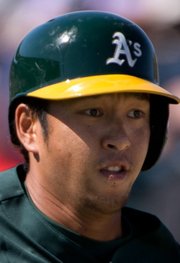River Cats’ Hiroyuki Nakajima playing back to form
Not long after Hiroyuki Nakajima joined the River Cats in early May, rehabbing from the spring training hamstring injury that hindered his bid for a job in the A’s infield, hitting coach Greg Sparks noticed the design on Nakajima’s personalized batting gloves.
The gloves included the name of Nakajima, the Japanese infielder signed by the A’s last winter, and the outline of a hitter with his body coiled and left leg lifted in a high kick, preparing to swing.
“Greg Sparks goes, ‘Who’s the hitter?’ ” River Cats manager Steve Scarsone said. “And (Nakajima) goes, ‘That’s me.’ But he was doing nothing like that.”
Instead, Scarsone said, the Nakajima he had seen in spring training and his first few rehab games “was trying to be very still” in the batter’s box.
That, Nakajima said Monday, was the result of changes he had made hoping to ease the transition to facing major-league pitching.
Nakajima, through translator Hiroo Nishi, said players and personnel in Japan had told him pitchers in America would throw harder than in the Nippon Professional Baseball League, where Nakajima was a career .302 hitter in 11 seasons. “And in order to cope with that image,” he said, “I kind of naturally changed my swing.”
In spring training, where he was expected to compete for the shortstop job in Oakland, Nakajima hit .167 (7 for 42) while making a team-high four errors before suffering the hamstring strain that landed him on the disabled list just before Opening Day.
He began his Triple-A rehab assignment May 3, and it was a little more than a week later in Nashville, Tenn., that Sparks saw the hitter on his batting gloves.
There, Scarsone said, he and Sparks “both kind of looked at (Nakajima) and said, ‘Hit like you.’ “
Nakajima said he has taken that and other advice to heart, while also realizing the gap in velocity he envisioned between Japanese and major-league pitching may have been exaggerated. The result: “Compared to spring training, I feel a lot more comfortable in the batter’s box,” he said. “My approach to the ball is now more my own self.”
Nakajima entered Monday hitting .279 in 35 games for the River Cats with six doubles and four home runs, including two in his previous three games.
But the player the A’s signed to a two-year, $6.5 million deal and introduced at a spirited news conference in December still has yet to play for Oakland.
After Nakajima’s rehab assignment ended on May 23, the A’s optioned him to Triple A, not wanting to break up the shortstop platoon of Jed Lowrie and Adam Rosales in Oakland.
“There are times, obviously, I feel it is kind of discouraging,” Nakajima said. “But there’s nothing I can do about it, no matter how strongly I feel about it. What I can concentrate on right now is working on the training and conditioning to get myself better situated for that invitation.”
Scarsone said he has seen “huge improvement” from Nakajima since early in his rehab stint, when Nakajima showed “a lot of hesitation,” possibly still favoring his hamstring.
“The bat speed is definitely much more – he’s on pitches better now,” Scarsone said. “I think his timing mechanism, like we talked about, is more natural for him, and he’s in a much better position to swing when he needs to and wants to.”
Asked if Nakajima is ready to hit major-league pitching, Scarsone said: “I think he’s really close.”
Defensively, Nakajima has played more third base recently than his natural shortstop, a shift he said “doesn’t feel weird.” Because third allows less reaction time, Nakajima has been working with the River Cats’ strength coach on quickening his first step, which Scarsone said should also make him more effective running the bases.
For a player who often looked tentative in the field in spring, Nakajima has shown good instincts on ground balls and a stronger arm than the A’s expected when he arrived in Arizona, Scarsone said. The new position may be a factor, Scarsone added. Without the years of experience in positioning himself and timing throws that he has at shortstop, Nakajima is apt to catch and release more quickly on plays at third.
Throughout, Scarsone said, “Our message to him is to play the way you play.
“That’s why we went out and got him, because of the success he’s had in Japan. We want that.”
As does Nakajima.
“The fact that I got injured, that was just completely out of my forecast,” said Nakajima, who said he has completely recovered from the injury.
“I’m ready,” he said. “If they tell me, ‘Come up here,’ I’m ready.”
via River Cats’ Nakajima playing back to form – Sacramento River Cats – The Sacramento Bee.




